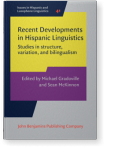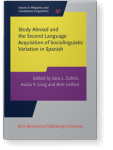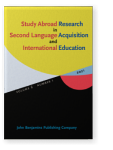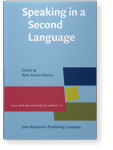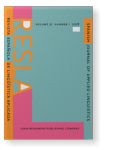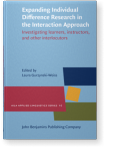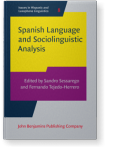Megan Solon
List of John Benjamins publications for which Megan Solon plays a role.
Book series
2023 Chapter 10. Variable outcomes abroad: Exploring the role of pre-program proficiency in the development of Spanish future-time expression Study Abroad and the Second Language Acquisition of Sociolinguistic Variation in Spanish, Zahler, Sara L., Avizia Y. Long and Bret Linford (eds.), pp. 292–320 | Chapter
Empirical research has reported differential effects of proficiency level on acquisition in the study-abroad (SA) context. We tested whether pre-SA proficiency influences learners’ acquisition of variable structures during SA, analyzing Spanish future-time expression, a structure conveyed… read more
2021 The impact of a short-term stay abroad on L2 Spanish syntactic complexity development in narratives Study Abroad Research in Second Language Acquisition and International Education 6:1, pp. 163–188 | Article
Given the notable increase in participation in short-term (e.g., eight weeks or less) study abroad, especially in the US, recent empirical work on the role of context in second language (L2) learning has sought to investigate the impact of a short-term stay abroad on language development. The… read more
2018 Chapter 1. Sociolinguistic competence and the acquisition of speaking Speaking in a Second Language, Alonso, Rosa Alonso (ed.), pp. 1–24 | Chapter
In face-to-face spoken interactions, language learners must construct a meaningful message consistent with the L2 grammar, articulate it comprehensibly, and manage the aspects of oral communication that reflect speaker identity, interlocutor identities, and the characteristics of the… read more
2018 Chapter 13. Examining multifaceted sources of input: Variationist and usage-based approaches to understanding the L2 classroom Usage-inspired L2 Instruction: Researched pedagogy, Tyler, Andrea E., Lourdes Ortega, Mariko Uno and Hae In Park (eds.), pp. 291–311 | Chapter
Input is a central, driving component in nearly all theories of second language acquisition, but little is known about the relationship between the instructor-provided input to which classroom second language learners are exposed and attested patterns of acquisition. Our study investigates this… read more
2018 Chapter 10. Acquisition of articulatory control or language-specific coarticulatory patterns? Evidence from the production of laterals in second-language Spanish Contemporary Trends in Hispanic and Lusophone Linguistics: Selected papers from the Hispanic Linguistic Symposium 2015, MacDonald, Jonathan E. (ed.), pp. 213–236 | Chapter
The present study examines the acquisition of coarticulatory patterns in Spanish as a second language (L2). Through an acoustic analysis of the production of /l/ preceded by a front vowel and by a back vowel by a large cross-sectional sample of English-speaking learners of Spanish (n = 85) and a… read more
2018 Chapter 4. Novel sounds: What L2 phonetic data might be telling us that we do not always hear Critical Reflections on Data in Second Language Acquisition, Gudmestad, Aarnes and Amanda Edmonds (eds.), pp. 89–124 | Chapter
Within the field of second-language (L2) phonetics, development in the production of a L2 phone is often conceived of as the modification of specific phonetic properties to approximate native-speaker norms. This approach permits precise accounts of L2 sound learning but can also lead to a narrow… read more
2018 Acquisition of sociophonetic variation: Intervocalic /d/ reduction in native and nonnative Spanish Revista Española de Lingüística Aplicada/Spanish Journal of Applied Linguistics 31:1, pp. 309–344 | Article
This study investigates the acquisition of nativelike variation in the production of Spanish /d/ by English-speaking learners. Specifically, we examine the production of /d/ in word-internal intervocalic position in the speech of 13 highly advanced nonnative speakers (NNSs) and 13 native… read more
2017 Chapter 6. Interaction and phonetic form in task completion: An examination of interlocutor effects in learner-learner and learner-heritage speaker interaction Expanding Individual Difference Research in the Interaction Approach: Investigating learners, instructors, and other interlocutors, Gurzynski-Weiss, Laura (ed.), pp. 121–148 | Chapter
The present study examines the effect of interlocutor type – second language (L2) learner versus heritage speaker – on interaction and phonetic accuracy during the completion of a dyadic map task in Spanish. Twenty intermediate-level, native English-speaking learners of Spanish and 10 heritage… read more
2016 Lexical frequency and subject expression in native and non-native Spanish: A closer look at independent and mediating effects Spanish Language and Sociolinguistic Analysis, Sessarego, Sandro and Fernando Tejedo-Herrero (eds.), pp. 197–216 | Article
This paper investigates the effect of lexical frequency on third-person subject form variation by native and highly-advanced non-native speakers of Spanish. In line with previous research, verb tokens which represented 1% or more of the total tokens were categorized as frequent whereas all others… read more
